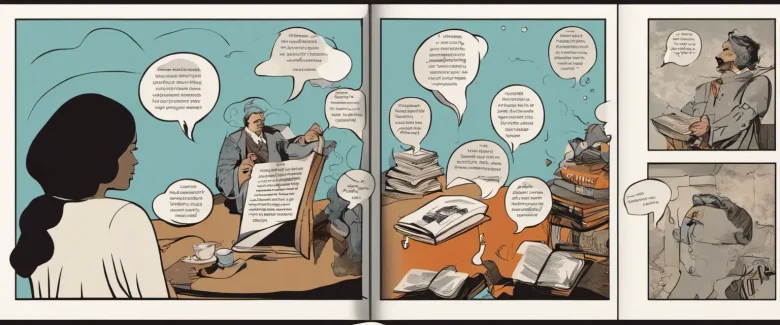Of Human Bondage, penned by William Somerset Maugham, is a captivating novel that delves into the complexities of human nature, love, and the eternal quest for self-discovery. Published in 1915, this timeless masterpiece follows the tumultuous life of Philip Carey, a young man bound by his own desires and insecurities. Maugham, an English playwright, novelist, and short-story writer, is widely regarded as one of the greatest storytellers of the 20th century. With a keen eye for human psychology and a gift for crafting rich and nuanced characters, Maugham weaves a narrative that explores the depths of human emotions and the everlasting struggle for personal freedom.
Chapter 1: Childhood and Orphanhood
Chapter 1 of “Of Human Bondage” by W. Somerset Maugham introduces the reader to the protagonist, Philip Carey, and his early years. The chapter begins by describing Philip’s upbringing in a village in England during the late 19th century.
As a child, Philip is orphaned at an early age, losing his mother to childbirth and his father to an unknown illness. Philip is sent to live with his paternal uncle, the vicar of Blackstable, who is a self-righteous and emotionally distant man. The vicar’s wife is a kind and well-meaning woman, but she fails to form a close bond with her young nephew.
Philip grows up with a clubfoot, which adds to his sense of isolation and self-consciousness. His disability not only affects his physical appearance but also limits his ability to participate in physical activities. Consequently, he develops a strong interest in books and prefers solitary pursuits.
The chapter further portrays Philip’s struggles with the religious beliefs instilled in him by his uncle. Feeling a lack of spiritual connection and skeptical of the strict religious doctrine he witnesses, Philip soon becomes disillusioned with religion. He starts to question the existence of God and the purpose of life.
Despite his childhood challenges and the emotional neglect he experiences, Philip develops a quiet determination to forge his own path in life. He feels an innate yearning for knowledge and desires to leave his provincial village in search of a broader education and experiences. This chapter sets the stage for Philip’s journey of self-discovery and explores themes of identity, religion, and the longing for freedom from societal constraints.
Chapter 2: Uncle William
Chapter 2 of “Of Human Bondage” introduces the readers to Philip Carey’s uncle, William, who becomes an instrumental figure in his life. Uncle William is a successful doctor and with his financial stability, he is able to provide a comfortable life for Philip’s fatherless existence. Despite his affluence, Uncle William disappoints Philip with his straightforward, blunt manner. Philip’s dreamy nature yearns for a more exciting and adventurous life, and Uncle William’s practical and sensible approach does not align with his imagination.
Uncle William’s wife, Aunt Louisa, is a well-meaning but overbearing woman, while their daughter, Fanny, is a plump and unintelligent girl who suffers from a variety of ailments. Philip finds their company dull, especially Aunt Louisa’s constant nagging. The monotony of his life is broken only by his regular visits to the vicarage, where he engages in lively conversations with the Vicar.
As Philip grows older, he becomes more aware of his physical appearance. He observes that his clubfoot, a birth defect, sets him apart from others, making him feel self-conscious and insecure. His classmates at school taunt him, which deepens his insecurity further. Uncle William proposes that Philip should become a doctor, a suggestion that initially unsettles him. However, the idea takes root in Philip’s mind as a potential escape from the mediocrity of his current life.
Chapter 2 portrays the stark contrast between Philip’s imaginative and dreamy nature and the practicality of his uncle and his family’s lifestyle. It foreshadows Philip’s internal struggle between conforming to societal expectations and following his own desires. Additionally, the chapter highlights the initial impact of Philip’s physical deformity on his self-esteem, which shapes his decisions and aspirations in the future.
Chapter 3: School Days
In Chapter 3 of “Of Human Bondage” by W. Somerset Maugham, the focus shifts to the main character, Philip Carey’s time at school. At the age of nine, following his mother’s death, Philip is sent to a boarding school called King’s School in Tercanbury. From the start, it becomes evident that Philip is different from his fellow students. He is physically weaker, with a clubfoot, which sets him apart from the others and subjects him to bullying and humiliation.
However, Philip’s isolation allows him to develop a strong sense of observation and introspection. He observes the different personalities and behaviors of those around him, and his acute sensitivity to the world helps him make sense of his own emotions. He discovers his passion for reading and finds solace in books.
As Philip’s time at school progresses, he encounters various characters. His first roommate, Athelny, an eccentric and flamboyant man, befriends him and introduces him to the world of art and literature. Athelny’s family becomes a refuge for Philip when he needs to escape the monotony of school life.
Despite his unpopularity, Philip’s academic performance remains excellent, earning him the admiration and respect of his teachers. This demonstrates his determination and resilience in the face of adversity. Additionally, Philip’s patronizing headmaster, Dr. Flemming, takes a special interest in him and recognizes his potential, helping him secure a scholarship to the prestigious King’s School in Blackstable.
Chapter 3 provides insight into Philip’s early school years, highlighting his struggle with bullying while also emphasizing his resilience and intellectual curiosity. These formative experiences lay the foundation for his character development as he grows older.
Chapter 4: Artistic Aspirations

Chapter 4 of “Of Human Bondage” by Somerset Maugham, titled “Artistic Aspirations,” explores the protagonist Philip Carey’s growing interest in art and the challenges he faces in pursuing his passion.
As the chapter begins, Philip’s guardians decide it is time for him to choose a career path. Rejecting the idea of the ministry, Philip finds himself captivated by art after attending a lecture by Professor Flanagan. Inspired by Flanagan’s words, Philip decides to pursue painting against the wishes of his guardian, Aunt Louisa.
Philip’s pursuit of art takes him to Paris, where he becomes a student at the art school known as the Beaux Arts. However, Philip quickly realizes that he lacks the innate talent possessed by some of his fellow students. Struggling with self-doubt, he realizes that his dedication and passion for art may not be enough to compensate for his lack of skill.
During a summer break, Philip travels to Germany to join his uncle, an art professor named William Carey. There, he finds a different approach to art, which encourages him to explore his own style rather than imitating others. Although Philip does not achieve great success with his paintings, he finds solace in the process itself, learning more about himself through his artistic endeavors.
Eventually, Philip’s lack of financial stability forces him to put his art dreams on hold and he returns to London to study medicine. However, despite his changing paths, Philip remains haunted by the allure of art and struggles to find a sense of purpose and fulfillment.
In Chapter 4, Maugham sets the stage for Philip’s ongoing struggle between his desire for artistic expression and his need for stability and practicality. The chapter highlights the complexities of pursuing one’s passion while also acknowledging the external pressures that influence life decisions.
Chapter 5: Life in Paris
Chapter 5 of “Of Human Bondage” by William Somerset Maugham introduces the protagonist, Philip Carey, as he arrives in Paris to pursue his artistic ambitions. The chapter depicts the challenges and experiences he encounters in the vibrant city.
Having grown up in a small town in England, Paris bewitches Philip with its lively atmosphere and artistic allure. He joins the art school, which he had longed to attend, and quickly immerses himself in the study of painting. However, he soon realizes his lack of natural talent and struggles to find his own style. Despite his dedication and hard work, Philip’s paintings are met with mediocrity and fail to impress his teachers.
Life in Paris introduces Philip to a diverse crowd of characters. He befriends Fanny Price, a fellow art student who shares his disappointment in their lack of artistic success. Fanny’s poor circumstances and a failed love affair have left her hopeless, eventually leading to her tragic end. This event leaves a deep impact on Philip, making him question the meaning and purpose of life.
While in Paris, Philip also experiences the thrill of romantic infatuation. He becomes infatuated with a young waitress named Norah Nesbit, who reciprocates his feelings. However, their relationship is short-lived as Norah’s true intentions become clear: she primarily desires Philip’s financial support. Disillusioned and heartbroken, Philip ends the affair.
Chapter 5 illuminates Philip’s struggles to find himself as an artist and understand the complexities of human relationships. Paris serves as a colorful backdrop for these formative experiences, and through his encounters, Philip begins to mature and gain a deeper understanding of the trials and tribulations of life.
Chapter 6: Love and Heartbreak
Chapter 6: Love and Heartbreak of the book “Of Human Bondage” by W. Somerset Maugham explores the complexities of love through the eyes of the main character, Philip Carey. The chapter delves into his infatuation with Mildred Rogers, a vulgar and manipulative woman who initially shows no interest in him.
At the beginning of the chapter, Philip confesses his feelings to Mildred, hoping for reciprocation. However, she rejects him and leaves him heartbroken. Despite this rejection, Philip finds himself unable to stop thinking about Mildred and continues to pursue her, desperately hoping to win her affections.
Mildred remains indifferent towards Philip and his affectionate gestures, often using him for money and disregarding his emotions. This unrequited love takes a toll on Philip, and he begins to neglect his studies and personal well-being. Mildred only continues to exploit his emotions, using his vulnerability to her advantage.
Philip’s friends and acquaintances try to persuade him to let go of Mildred, recognizing her toxic influence on him. However, he remains blind to their advice, blinded by his love for her. As the chapter progresses, Philip’s obsession with Mildred becomes more apparent, showcasing the destructive power love can have on one’s life.
The chapter concludes with Philip discovering Mildred in an intimate embrace with another man. This betrayal shatters Philip, reinforcing the painful reality of their one-sided relationship. Heartbroken and humiliated, Philip is left to confront the consequences of his unrequited love and the self-destructive path it has led him down.
In summary, Chapter 6 explores Philip’s infatuation with Mildred Rogers, his willingness to overlook her faults, and the far-reaching consequences of unrequited love on his life. Heartbreak, desperation, and rejection are central themes, offering a compelling insight into the complexities of human emotion and the delicate nature of relationships.
Chapter 7: Medical School and New Beginnings
Chapter 7 of “Of Human Bondage” by William Somerset Maugham follows Philip’s journey into medical school and his experiences as a student. The chapter explores his struggles, new friendships, and the beginning of his journey towards self-discovery.
Philip enters medical school with high hopes, only to be disappointed by the lackluster professors and tedious lectures. He finds the subjects uninteresting, and the professors unenthusiastic, making it difficult for him to find motivation. Despite these obstacles, Philip is determined to persevere and succeed in his studies.
During this time, Philip befriends a fellow student named Griffiths, a charismatic and confident classmate who captivates him with tales of his romantic escapades. Philip is both fascinated and envious of Griffiths’ adventurous nature, which provides a stark contrast to Philip’s introverted and cautious demeanor.
However, it is not long before Philip realizes that Griffiths is not the friend he envisioned. Griffiths repeatedly borrows money from Philip, promising to repay it but consistently failing to do so. This gradually sours their friendship and leads Philip to question his own judgment.
In addition to his disappointing friendships, Philip also struggles with financial difficulties. He is forced to live frugally and finds solace in his other classmates who empathize with his situation. These new acquaintances provide Philip with a support system and a sense of camaraderie.
Despite the challenges he faces, Philip starts to forge his own path and become more independent. He begins to question societal norms and religious beliefs, exploring new ideas and philosophies. These experiences mark the first steps in his journey towards self-discovery and a deeper understanding of his true passions and desires.
Overall, Chapter 7 of “Of Human Bondage” showcases Philip’s struggles in medical school, the disappointment with his friend Griffiths, and the beginnings of his exploration of self-identity and personal beliefs.

Chapter 8: Embracing Freedom
In Chapter 8 of “Of Human Bondage” by W. Somerset Maugham, the protagonist, Philip Carey, embarks on a new phase of his life at King’s School. As he settles into his new surroundings, Philip begins to experience a newfound sense of freedom.
At the beginning of the chapter, Philip is described as being in awe of the school. He feels liberated from the constraints of his upbringing and discovers a whole new world of possibilities. He quickly befriends the other boys, who introduce him to various activities and adventures. This exhilarating sense of freedom and camaraderie is a stark contrast to the strict confines of his childhood home.
As time goes on, Philip becomes more aware of the freedom that comes with making his own choices. He revels in the privilege of deciding what subjects to study, what books to read, and how to spend his free time. This independence allows him to cultivate his interests and shape his own identity.
However, Philip soon realizes that this newfound freedom also comes with its own challenges. He becomes aware of his own limitations and struggles with certain subjects. Additionally, he falls under the influence of a charismatic classmate named Rose, who leads him into trouble.
Overall, Chapter 8 of “Of Human Bondage” explores the theme of embracing freedom and the possibilities it offers. As Philip navigates the opportunities and pitfalls of his new life at King’s School, he learns to appreciate the positive aspects of freedom while grappling with its inherent challenges.
After Reading
In conclusion, William Somerset Maugham’s novel, “Of Human Bondage,” explores the intricacies of human nature and the powerful forces that can shape an individual’s life. Through the protagonist, Philip Carey, we witness a journey of self-discovery and the pursuit of personal freedom. Set in early 20th-century England, the book delves deep into themes of love, art, religion, and ambition. Throughout the narrative, Maugham skillfully examines the complexities of human relationships, illustrating how they can both liberate and enslave us. “Of Human Bondage” stands as a timeless and thought-provoking work, reminding readers of the relentless struggles and triumphs of the human spirit.
1. “To Kill a Mockingbird” by Harper Lee – This classic novel explores themes of racial injustice and the loss of innocence through the eyes of a young girl named Scout. With powerful storytelling and memorable characters, Lee’s masterpiece offers a poignant examination of societal prejudice and the fight for justice.
2. “Pedro Páramo” by Juan Rulfo – In this Mexican novel, Rulfo weaves a haunting and surreal tale about a man’s return to his deceased mother’s hometown. Through a brilliant blend of magical realism and vivid descriptions, Rulfo skillfully unravels a complex narrative that delves into themes of identity, solitude, and the illusory nature of memory.
3. “War and Peace” by Leo Tolstoy – Considered one of the greatest works of literature, Tolstoy’s epic novel takes readers on a journey through Russian society during Napoleon’s invasion. With its vast and diverse cast of characters and profound insights into human nature, this grand story explores themes of love, war, and the search for meaning in life.
4. “The Catcher in the Rye” by J.D. Salinger – This coming-of-age novel follows Holden Caulfield, a disaffected teenager struggling with the phoniness of the adult world. Salinger’s iconic work resonates with readers of all ages, capturing the uncertainty and rebellion of youth while questioning the values of society.
5. One Hundred Years of Solitude” by Gabriel García Márquez – Offering a captivating blend of reality and magical elements, Márquez’s masterpiece takes readers on a passionate journey through one family’s history in the fictional town of Macondo. With its rich storytelling and exploration of love, time, and the cycles of life, this novel is a paramount example of magical realism that immerses readers in a spellbinding world.



